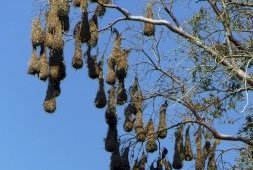
La Région Lacan-Tún – Usumacinta is proposed as a mixed site by Mexico. It encompasses large areas of tropical forest in eastern Chiapas, notably the flora and fauna protection area Nahá-Metzabok, the flora and fauna protection area Chankin, the natural monument Bonampak, the natural monument Yaxchilán, the biosphere reserve Montes Azules, the biosphere reserve Lacan – Tún and the communal reserve La Cojolita. The nomination file claim an OUV from the high biodiversity of the area as well as the Mayan remains. I visited Mexico in 2019 and visited two components of this site: Yaxchilán and Bonampak
Yaxchilán
One cool thing about Yaxchilán is that it can only be reached after a 45 minutes boat ride on the Río Usumacinta starting in Frontera Corozal. The site is therefore situated in the middle of the jungle in a bend of the river. The setting is great and the wildlife is abundant (birds, butterflies, howler monkeys). The city was once a powerful Mayan state. The site, even though it is not as impressive as other archaeological sites nearby (Palenque, Tikal), is interesting and posses some unique features. Among these, it is particularly fascinating to walk inside the rooms and stairways of El Laberinto (Edificio 19, the Labyrinth) and get lost among the bats, tree frogs, and whip spiders that now occupy the structure. El Edificio 33 is situated atop a long stairway and is the best preserved temple with its beautiful stone lintels and sculptures (Yaxchilán is famous for its lintels). Edificios 39, 40 and 41 are more isolated and offered us a close encounter with a howler monkeys family.
Bonampak
Bonampak is much smaller. All structures here are located around one Gran Plaza. The most famous structures are the 6 meters high Stela 1 and the Templo de las Pinturas. The later contains Mayan frescoes of great quality (actually the best of any Pre-Columbian civilization according to my Lonely Planet) showing scenes of nobility, war, and torture. Those murals broke the myth that Mayans were a peaceful civilization. For birders here, check the big tree in front of the temple to the left; it is full of Montezuma oropendola's hanging nests (picture).
Logistic
We booked a tour including the transfer to Flores in Guatemala (Tikal) in Palenque. Most tour operators are offering it. We left Palenque early on the first day, had breakfast en route and then visited Yaxchilán. We thereafter had lunch in Frontera Corozal and visited Bonampak. We had dinner and slept in cabañas at the entrance of Bonampak. It allowed me to take a small walk in the morning at the entrance of the natural monument to watch wildlife (birds and an agouti). We had breakfast there the next morning, and the group going the Yaxchilán pick us up to Frontera Corozal again where we did the Mexican immigration formalities and took the boat to Guatemala. We left in another bus, stopped for immigration and reach Flores after a long and tiring day. It's probably possible to do the same things independently, but I enjoyed how we did it.
Final thought
Mesoamerican rain forests and Mayan ruins are already well represented on the list. However, those seem to add something to the existing properties and therefore could claim for OUV. A transnational nomination with Guatemala would make sens to me.
Finally, please note that Bonampak was also included in a former tentative site. Solivagant wrote a very interesting review from his 1971 visit.
Comments
No comments yet.
